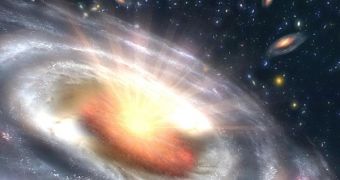It's common knowledge that black holes reside in the center of each galaxy, where they happily feed on galactic gases emanating from dying stars and other cosmic bodies, such as planetary nebulas. But, in the case of two known galaxies, M31, our “neighbor” the Andromeda Galaxy, and NGC 5866, there are no radiation readings coming out of them, which means that the black holes in their middle do not operate. But what could make a black hole unable to consume matter? astronomers ask.
For years, they've assumed that gravitational pull from surrounding galaxies forced the gases used by the black hole to move out of the central bulges of the galaxies, where they could mostly be found. In this area, located right around the black hole, stars emit large amounts of gases and other matter, which is inevitably drawn to the high-density center of the black hole. In the process, it gives off powerful radiation readings that can be easily recorded, even from far away.
Now, researchers at the University of Massachusetts at Amherst, led by Q. Daniel Wang, say that they may have found an explanation for the apparent lack of activity on the part of the black hole. They say that supernovas are to blame, and, especially, those of them that explode constantly. They create ripples in the fabric of the galaxy, much like a tsunami creates ripples on the oceans following a tremor.
Basically, the further the shock waves get from the supernova, the more damage they make. And when they hit the cold gases in the center of galaxies, they make them evaporate, at a rate that is much higher than the force with which the gravitational pull of the black hole attracts them. Successive pounding means that accumulating gas is constantly eliminated, virtually cutting the “food” supply of the black hole.
Wang also notes that it's these interferences from supernovas that most likely stop the formation of younger galaxies, as the black holes inside them have not yet had the time necessary to grow powerful enough. In the case of older galaxies, with a supermassive back hole in the middle, the gravitational pull is so large that even successive supernova attacks fail, and gas still gets pulled in.

 14 DAY TRIAL //
14 DAY TRIAL //